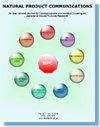基于数据挖掘、网络药理学和分子对接技术,探索中药治疗绝经后骨质疏松症的规律和机制
IF 1.4
4区 医学
Q4 CHEMISTRY, MEDICINAL
引用次数: 0
摘要
绝经后骨质疏松症(PMOP)是原发性骨质疏松症的重要组成部分,目前临床上对PMOP的治疗方案容易受到副作用和不良反应的限制,因此寻求更高效、安全、经济的药物治疗PMOP显得尤为重要。近年来,随着疾病治疗模式的转变和中医药对原发性骨髓瘤研究的逐步深入,查阅文献发现,关于中医药治疗原发性骨髓瘤的研究数量庞大,但对其组方规律及核心药物发挥疗效的具体机制尚无相关的系统研究。因此,在本研究中,我们共收集了141个中医临床医生治疗原发性骨髓瘤的方剂,统计分析了其高频药物、四气、五味、经络和功效、并根据关联规则分析了地黄、淫羊藿、杜仲、黄连、当归、牛膝、黄芪、车前子、山茱萸、甘草等核心药物。相关性分析共得出 87 对药物,根据聚类分析共得出 8 组潜在的核心复方药物和 4 个潜在的新处方。随后,对核心药物进行了网络药理学分析,得到了核心药物中的 173 种有效成分,包括山奈酚、β-谷甾醇、槲皮素等。298 个作用靶点,包括 MAPK3、STAT1、HSP90AA1 等。170 个信号通路,包括 AGE-RAGE、PI3 K/Akt、TNF、HIF-1 等。分子对接结果显示,核心药物中的11种关键活性成分与靶标有稳定的结合。该研究表明,中医治疗原发性血小板增多症以 "补肝肾、温脾胃、活血化瘀 "为主。核心药物治疗原发性骨髓瘤是通过多成分、多靶点、多途径的综合干预。通过综合分析,计算出11种关键有效成分与11个关键靶点的最小结合能,表明核心药物与其治疗靶点具有良好的结合活性,证明本研究的预测结果是可靠的。今后,将为中医药治疗原发性骨髓瘤提供一定的用药依据和数据支持。本文章由计算机程序翻译,如有差异,请以英文原文为准。
To Explore the Rule and Mechanism of Traditional Chinese Medicine in the Treatment of Postmenopausal Osteoporosis Based on Data Mining, Network Pharmacology and Molecular Docking Technology
Postmenopausal osteoporosis (PMOP) is an important part of primary osteoporosis, and the current clinical treatment program for PMOP is easily limited by side effects and adverse reactions, so it is particularly important to seek more efficient, safe, and economical drug treatment for PMOP. In recent years, with the change of disease treatment mode and the gradual deepening of Traditional Chinese medicine (TCM) research on PMOP, a review of the literature reveals that there is a huge number of studies on the use of TCM in the treatment of PMOP, but there are no relevant systematic studies on the rules of its formulas and the specific mechanisms by which the core drugs exert their therapeutic effects. Therefore, in this study, we collected a total of 141 formulas used by TCM clinicians to treat PMOP, statistically analyzed their high-frequency medications, Four Qi, Five Flavors, meridians, and efficacies, and analyzed the core medications based on the association rules, which were Rehmanniae Radix Praeparata, Epimedium, Eucommia ulmoides, Rhizoma Drynariae, Angelica sinensis, Achyranthes, Astragalus propinquus, Psoralen, Cornus officinalis and licorice. A total of 87 drug pairs were obtained from the correlation analysis, and a total of 8 groups of potential core combination drugs and 4 potential new prescriptions were derived based on the cluster analysis. Subsequently, a network pharmacological analysis of the core drugs was conducted to obtain 173 active ingredients in the core drugs, including kaempferol, β-sitosterol, quercetin, etc. 298 targets of action, including MAPK3, STAT1, HSP90AA1, etc. 170 signaling pathways including AGE-RAGE, PI3 K/Akt, TNF, HIF-1 and others. The molecular docking results showed that 11 key active ingredients in the core drugs had stable binding to the target targets. This study showed that TCM treatment of PMOP is mainly based on “reinforcing liver and kidney, warmly invigorating spleen and stomach, activating blood and resolving stasis.” Core drugs therapy for PMOP is a comprehensive intervention through multi-component, multi-target, and multi-pathway approaches. The minimum binding energies between the 11 key active ingredients and the 11 key targets were calculated in a comprehensive analysis, which shows that the core drugs have good binding activities to their therapeutic targets, proving that the predictions of this study are reliable. In the future, it will provide certain medication basis and data support for TCM treatment of PMOP.
求助全文
通过发布文献求助,成功后即可免费获取论文全文。
去求助
来源期刊

Natural Product Communications
工程技术-食品科技
CiteScore
3.10
自引率
11.10%
发文量
254
审稿时长
2.7 months
期刊介绍:
Natural Product Communications is a peer reviewed, open access journal studying all aspects of natural products, including isolation, characterization, spectroscopic properties, biological activities, synthesis, structure-activity, biotransformation, biosynthesis, tissue culture and fermentation. It covers the full breadth of chemistry, biochemistry, biotechnology, pharmacology, and chemical ecology of natural products.
Natural Product Communications is a peer reviewed, open access journal studying all aspects of natural products, including isolation, characterization, spectroscopic properties, biological activities, synthesis, structure-activity, biotransformation, biosynthesis, tissue culture and fermentation. It covers the full breadth of chemistry, biochemistry, biotechnology, pharmacology, and chemical ecology of natural products.
Natural Product Communications is a peer reviewed, open access journal studying all aspects of natural products, including isolation, characterization, spectroscopic properties, biological activities, synthesis, structure-activity, biotransformation, biosynthesis, tissue culture and fermentation. It covers the full breadth of chemistry, biochemistry, biotechnology, pharmacology, and chemical ecology of natural products.
 求助内容:
求助内容: 应助结果提醒方式:
应助结果提醒方式:


